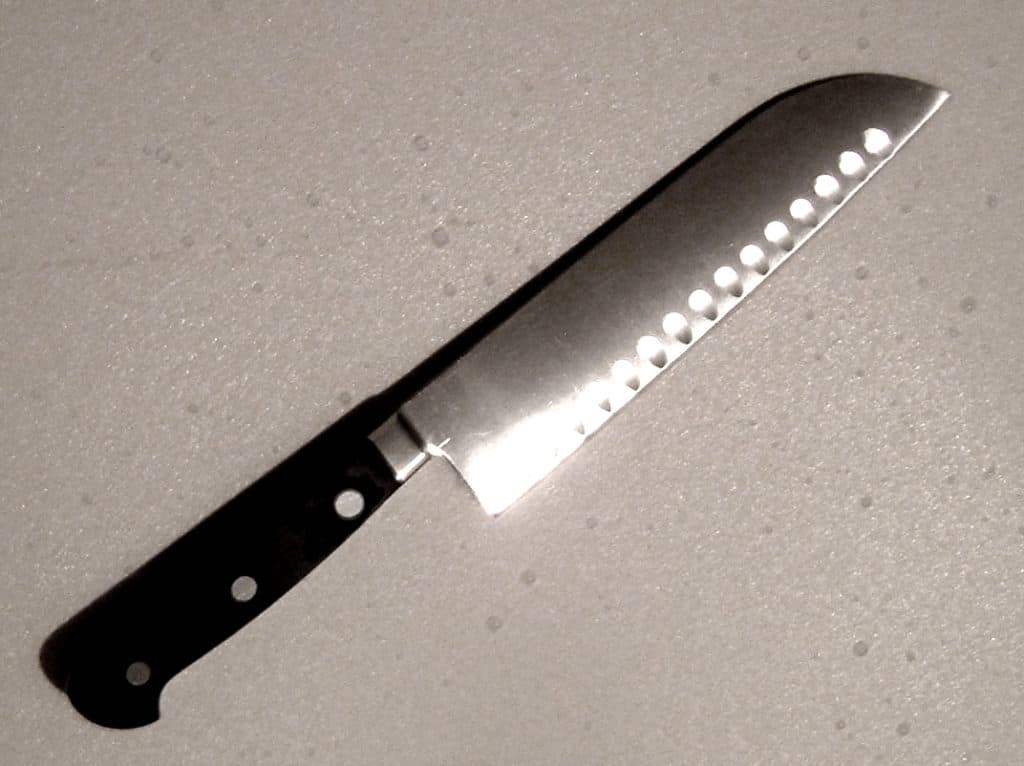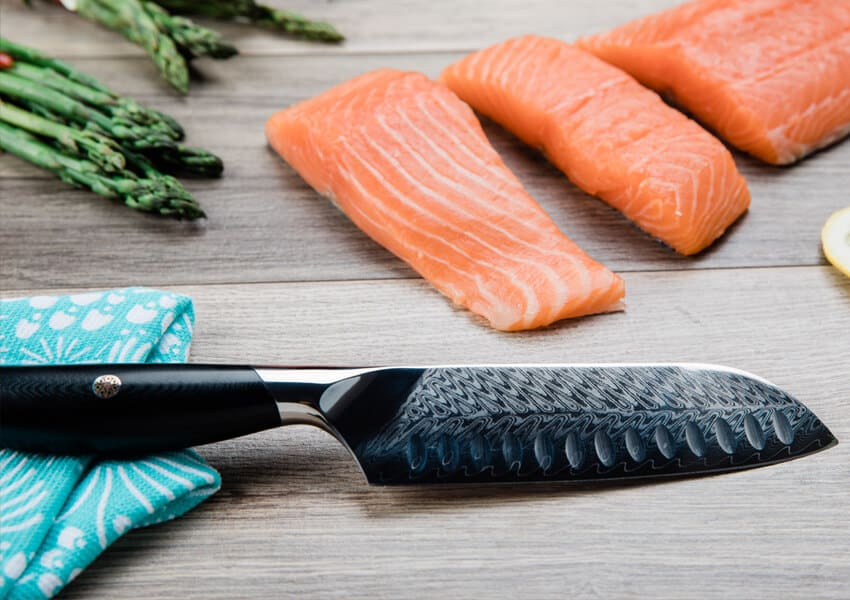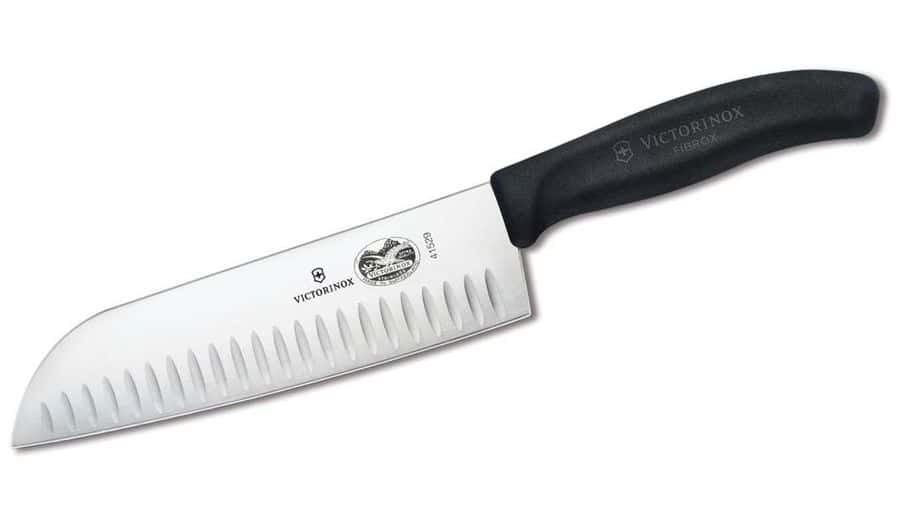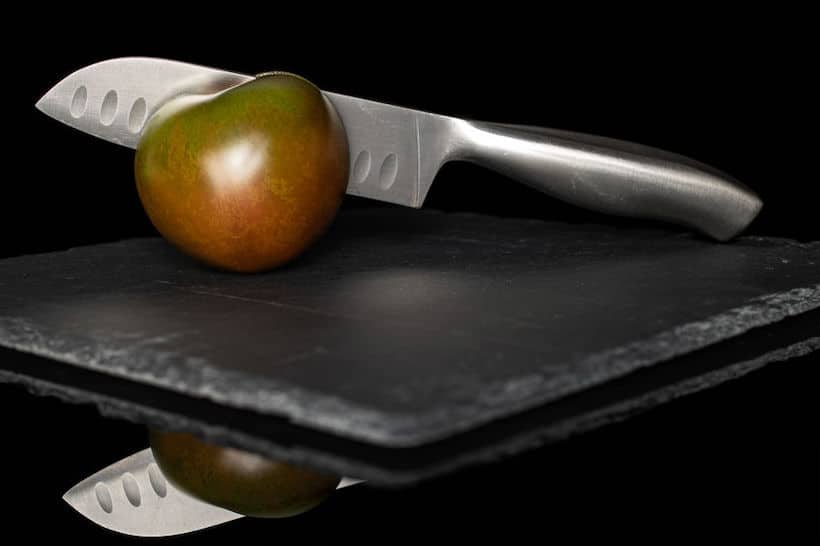To begin with, what is a Santoku Knife? A Santoku Knife is a multipurpose kitchen knife, which is originated in Japan. The native name for it is “The Santoku bōchō”. The blade of this kind of knife is generally 13 to 20 centimeters in length.
This type of knife employs the Sheep’s Foot Blade design, drawing the spine or backstrap of the blade all the way down.
The blade of this kind of knife is typically flattened. They have evolved from the traditional Japanese vegetable knife which sports a sharp flat blade. This knife is shorter, thinner and better, and more hardened than a typical Western cooking knife. This is owed to the Japanese Samurai culture, known worldwide for their beliefs in honour and their blade crafting prowess.
Contents
1. What does santoku mean?

The term Santoku can be broken down into two parts- “san” which stands for three, and “toku” which means virtue. In English, it literally translates to “three virtues”. This means that it is designed for three particular functions.
2. What is a Santoku Knife Used For?
A Santoku Knife is traditionally a general-purpose kitchen knife, used mainly for culinary purposes. The three main uses are mincing, dicing, and slicing. Owing to the flat, wide blade, it can also be used to scoop food off a cutting board easily.
3. What is a Santoku knife used to cut?

The Santoku Knife can be used to mince, dice, and slice pretty much whatever the recipe entails. It can be used for cutting meat, slicing cheese, mince vegetables, or dicing, slice, and chop any vegetables or meats as required.
4. What is the difference between a Santoku knife and a vegetable knife?
In concerns of designs, the Japanese vegetable knife, i.e., the Nakiri, has a flat end meaning it does not have a point, whereas the Santoku has a pointed end. In the terms of utility, the vegetable knife is designed to primarily cut vegetables, and the Santoku is more of a multipurpose cooking knife.
5. What is the right size knife Santoku?

There is no right size per-se. There are variations in sizes of Santoku knives called mini-santoku, which measure about 12.5 cm. The standard size in Japan is about 14 cm in length. The length of Santoku knives can go up to 20 cm.
6. What are the dents in a santoku knife called?
The dents or dimples on the side of the blade of these knives are called kullenschliff or a Granton edge. These dimples are the reason Santoku knives are grouped under hollow edge knives. They are present to provide less friction and to prevent food from sticking to the blade.
7. What is a rocking Santoku knife?

A rocking Santoku Knife is a mix between a Western cooking knife and a Santoku. A key difference is that the spine of the blade is curved upwards, rather than in a traditional Santoku that has a flat spine. This allows for Western-style circular motion and Asian-style chopping.
8. What is a rocking Santoku knife used for?
A rocking Santoku is used to chop, dice, slice and mince vegetables or meats or cheeses, just like a regular Santoku. The only difference is that this variation allows for the use of the rocking motion while cutting with it, unlike the regular Santoku.
9. What is the advantage of a Santoku knife?

The Santoku knife has a distinct advantage as compared to regular chef’s knives since it has a narrower blade, which allows for thinner cuts. It is also much lighter than conventional knives. The hollow edge also makes sure there is no friction and that no food sticks to the blade.
FAQs
1. Do you really need a Santoku knife?
The answer to this question is no, you do not necessarily need a Santoku knife. If you are searching for new knives to try out then it is not a bad idea to try this option out. However, unless you’re accustomed to the Asian chopping styles, controlling this knife and getting the best out of it will prove to be a bit of a challenge. These knives are only useful for those who have practice with them and are familiar with the chopping style it takes to operate them correctly.
2. What is the purpose of a Santoku Knife?
It is useful since it is lighter and shaped differently than other knives. The main part is the design that helps a certain style of cutting motion.
3. What is a hollow edge santoku knife used for?
These dimples are the reason Santoku knives are grouped under hollow edge knives. They are present to provide less friction and to prevent food from sticking to the blade
4. How do you use a Santoku knife?
It is most optimal to use this knife in a downward swift motion. The to and fro motion is also an option while using the Santoku. The only motion that this knife is not compatible with would be the rocking motion since the blade has a slight upward curve which will not support a rocking motion while cutting too well.
5. Can a Santoku knife be used to cut meat?
Yes, the Santoku can be used to cut meat, among other things.
6. Who makes the best Santoku knife?
According to where the knife has originated it would be safe to assume that the Japanese would be the best at making a proper Santoku. But ah, well, globalization is a thing. After a bit of research, you can come across some of the most popular Santoku knife retailers.
7. Why do Santoku knives have dimples?
As already mentioned in this article, a distinct feature of the Japanese Santoku knives is the dimples or the dents found on the side of the blade. This set of dimples, known specifically as kullenschliff or a Granton edge is there to allow air to pass between the surface of the blade and the item being sliced. This makes sure that the item in question does not stick to the blade. This reduces the friction and allows for smoother cuts and narrower slicing.





